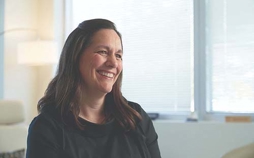Seeing as Christ Sees
By Bishop W. Christopher Waddell, First Counselor in the Presiding Bishopric
April 2021
My dear friends, I bring the Presiding Bishopric’s love and appreciation for all you do to build the kingdom. With all that is going on in the world at this time, I express my gratitude for an all-knowing God; for His Son, our loving Savior Jesus Christ; and for our dear prophet, President Russell M. Nelson. Be assured that the Lord’s guidance will provide protection and support to the extent that we heed and act upon His counsel.
We’re all familiar with the parable of the good Samaritan. There is a principle I believe that the Lord is teaching us that He wants us to recognize, a principle that is a Christlike attribute. Beginning in verse 31 of Luke 10, it says:
And by chance there came down a certain priest that way: and when he saw him, he passed by on the other side.
And likewise a Levite, when he was at the place, came and looked on him, and passed by on the other side.
But a certain Samaritan, as he journeyed, came where he was: and when he saw him, he had compassion on him,
And went to him, and bound up his wounds, pouring in oil and wine, and set him on his own beast, and brought him to an inn, and took care of him. [Luke 10:31–34]
With that story in mind, we then discover in chapter 25 of Matthew three wonderful parables. In the third parable—of the sheep and the goats—we read:
For I was an hungred, and ye gave me meat: I was thirsty, and ye gave me drink: I was a stranger, and ye took me in:
Naked, and ye clothed me: I was sick, and ye visited me: I was in prison, and ye came unto me.
Then shall the righteous answer him, saying, Lord, when saw we thee an hungred, and fed thee? or thirsty, and gave thee drink?
When saw we thee a stranger, and took thee in? or naked, and clothed thee?Or when saw we thee sick, or in prison, and came unto thee? [Matthew 25:35–39]
How does Christ respond to them? “Inasmuch as ye have done it unto one of the least of these my brethren, ye have done it unto me” (verse 40).
And then He speaks again: “For I was an hungred, and ye gave me no meat: I was thirsty, and ye gave me no drink” (verse 42).
And their response is: “Lord, when saw we thee an hungred, or athirst, or a stranger, or naked, or sick, or in prison, and did not minister unto thee?”
And we know His response to them: “Inasmuch as ye did it not to one of the least of these, ye did it not to me” (verse 45).
Do you see the principle? There’s a similar word or phrase that’s used in both of these parables a few different times. Did you recognize what the word or phrase was? They have to do with vision: “He saw him.” “When saw we thee?”
There were two individuals before the Samaritan who saw and looked. The Samaritan saw. To the priest and the Levite—who saw but did not see—it was all about them. To the good Samaritan—who gave the food, gave the drink, made the visit—it was about someone else; it wasn’t about him. The difference between these individuals is seeing by the Spirit. It is looking outward rather than inward, looking toward others instead of toward ourselves. It is seeing as Jesus Christ sees. Vision to see as the Savior sees is an attribute of Christ that we all need to develop.
Beginning with the End in Mind
President Nelson invites us to “begin with the end in mind.” The first time I heard him use that particular phrase was when he was Elder Nelson and was speaking to a group of new mission presidents and their wives. The next time I heard him use the phrase was when he was called as a new prophet, and it was in his opening interview. And this was his response to a young person in Australia who asked him for advice on gaining her own testimony. The prophet replied, “Begin with the end in mind.” And he added, “What would you like said about you at your funeral? . . . I can’t imagine better motivation than to know you are making progress every day.”
“And the Lord called his people Zion, because they were of one heart and one mind, and dwelt in righteousness; and there was no poor among them.” —Moses 7:18
To begin with the end in mind we must be able to see the end, to have vision. Some of the individuals we read about in Luke and Matthew were able to see the end beyond what was just in front of them. As disciples of Jesus Christ, we begin with the end in mind when we look to lift, to bless, and to gather Israel, when we turn our focus on how we can prepare ourselves, our families, and others for the return of the Savior. When we do that—when we see as the Savior sees and when we have vision to see the end—we will be more effective in what we do.
When Elder Nelson was telling those mission presidents to teach their missionaries to begin with the end in mind, he said there is a very clear difference between missionaries who do not begin with the end in mind and those who do. Missionaries who just see a tally sheet with the number of baptisms do not have the vision of missionaries who envision these people in the temple and recognize that temple ordinances are the end and baptism is the means to that end.
Acting in Faith
Elder Neal A. Maxwell taught that the Savior had a particular mission as the Son of God and as the Son of Mary. Elder Maxwell said we cannot do what He did, but we can do as He did. We can develop that characteristic, that attribute of seeing as Christ sees, looking outward beyond ourselves and seeing that it’s not about us; it’s about others—and it’s about Christ, who is the beginning and the end.
As we seek to see as Christ sees, we will be blessed with opportunities to forget self and lift others. These opportunities may often be inconvenient and test our desire to become more like the Master, whose greatest service of all, His infinite Atonement, was anything but convenient. In Matthew chapter 25, we are reminded how the Lord feels about us, when, like Him, we are sensitive to the struggles, trials, and challenges faced by so many but that can often be overlooked.
As you begin your journey with the end in mind, consider your role in assisting the Lord as He hastens His work. The story of the good Samaritan illustrates how looking beyond long-held prejudices to provide selfless acts of service is what unites us—it is what helps us see that we truly are all brothers and sisters, children of a loving God. I testify that seeing as Christ sees will bring us closer to Enoch’s grand vision: “And the Lord called his people Zion, because they were of one heart and one mind, and dwelt in righteousness; and there was no poor among them” (Moses 7:18).




